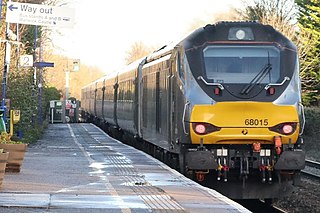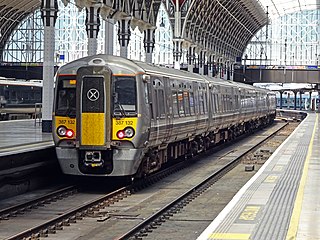
Paddington, also known as London Paddington, is a London railway station and London Underground station complex, located on Praed Street in the Paddington area. The site has been the London terminus of services provided by the Great Western Railway and its successors since 1838. Much of the main line station dates from 1854 and was designed by Isambard Kingdom Brunel. As of the 2022–23 Office of Rail & Road Statistics, it is the second busiest station in the United Kingdom, after London Liverpool Street, with 59.2 million entries and exits.

Thames Trains was a train operating company in the United Kingdom owned by Go-Ahead Group, which operated the Thames Trains franchise from October 1996 until March 2004.

Chiltern Railways is a British train operating company that has operated the Chiltern Railways franchise since July 1996. Since 2009, it has been a subsidiary of Arriva UK Trains.

Heathrow Express is a high-frequency airport rail link operating between London Heathrow Airport and London Paddington. Opened in 1998, trains run non-stop, with a journey time of 15 minutes. The service is operated jointly by Great Western Railway and Heathrow Express Operating Company, a wholly owned subsidiary of Heathrow Airport Holdings. Around 16,000 passengers use the service each day.

West Ealing railway station is on the Great Western Main Line in Ealing, situated in west London. It is 6 miles 46 chains (10.6 km) down the line from London Paddington and is situated between Ealing Broadway to the east and Hanwell to the west. Its three-letter station code is WEA.

The Great Western Main Line (GWML) is a main line railway in England that runs westwards from London Paddington to Bristol Temple Meads. It connects to other main lines such as those from Reading to Penzance and Swindon to Swansea. The GWML is presently a part of the national rail system managed by Network Rail while the majority of passenger services upon it are provided by the current Great Western Railway franchise.

Great Western Railway (GWR) is a British train operating company owned by FirstGroup that operates the Greater Western passenger railway franchise. It manages 197 stations and its trains call at over 270. GWR operates long-distance inter-city services along the Great Western Main Line to and from the West of England and South Wales, inter-city services from London to the West Country via the Reading–Taunton line, and the Night Riviera sleeper service between London and Penzance. It provides outer-suburban services in West London; commuter services from its London terminus at London Paddington to the Thames Valley region, including parts of Berkshire and Buckinghamshire, and Oxfordshire; and regional services throughout the West of England and South Wales to the South coast of England. Great Western Railway provides and maintains the Electrostar Class 387 fleet for Heathrow Express.
A train operating company (TOC) is the term used on the railway system of Great Britain for a railway undertaking operating passenger trains under the collective National Rail brand. TOCs have existed since the privatisation of the network under the Railways Act 1993.

The British Rail Class 166 Networker Turbo is a fleet of diesel multiple unit (DMU) passenger trains, built by ABB Transportation at their Holgate Road Works in York between 1992 and 1993. They were specified by and built for British Rail, the state-owned railway operator in Great Britain at the time. The trains were designed as a faster, air-conditioned variant of the Class 165 Turbo, intended for longer-distance services, and, like the 165s, belong to the Networker family of trains. They were originally known as Networker Turbos to distinguish them from the electrically propelled members of that family. Today the 166s, alongside the 165s, are normally referred to as Thames Turbos or just simply Turbos.

The British Rail Class 165 Networker Turbo is a fleet of suburban diesel multiple unit passenger trains (DMUs), originally specified by and built for the British Rail Thames and Chiltern Division of Network SouthEast. They were built by BREL York Works between 1990 and 1992. An express version was subsequently built in the form of the Class 166 Networker Turbo Express trains. Both classes are now sometimes referred to as "Networker Turbos", a name derived some three years later for the project that resulted in the visually similar Class 365 and Class 465 EMUs.

The Chiltern Main Line is a railway line which links London (Marylebone) and Birmingham on a 112-mile (180 km) route via High Wycombe, Bicester, Banbury, Leamington Spa and Solihull in England.

Reading railway station is a major transport hub in Reading, Berkshire, England; it is 36 miles (58 km) west of London Paddington. It is sited on the northern edge of the town centre, near to the main retail and commercial areas and the River Thames. It is the busiest station in Berkshire, and the third busiest in South East England.

The Greenford branch line is a 2 miles 40 chains (4.0 km) Network Rail suburban railway line in west London, England. It runs northerly from a triangular junction with the Great Western Main Line west of West Ealing to a central bay platform at Greenford station, where it has cross-platform interchanges to the London Underground's Central line. A triangular junction near Greenford connects to the Acton–Northolt line. The line serves mainly the suburbs of Ealing and Greenford.

Hayes & Harlington is a railway station serving the west London districts Hayes and Harlington in the London Borough of Hillingdon. It is 10 miles 71 chains down the line from London Paddington and is situated between Southall and West Drayton.

Oxford railway station is a mainline railway station, one of two serving the city of Oxford, England. It is about 0.5 miles (800 m) west of the city centre, north-west of Frideswide Square and the eastern end of Botley Road. It is the busiest station in Oxfordshire, and the fourth busiest in South East England.

The Acton–Northolt line (ANL), historically known as the New North main line (NNML), is a railway line in West London, England. Built between 1903 and 1906, it runs from the Great Western Main Line at Old Oak Common TMD to the Chiltern Main Line at South Ruislip, alongside the West Ruislip branch of the London Underground Central line, for a distance of around 11 miles (18 km).

In the 2010s Network Rail modernised the Great Western Main Line, the South Wales Main Line, and other associated lines. The modernisation plans were announced at separate times but their implementation overlapped in the 2010s.

Greater Western is a railway franchise for the provision of passenger services from London Paddington to the Cotswolds, West of England, South West England and South Wales. The current holder is Great Western Railway.

The British Rail Class 387 Electrostar is a type of electric multiple unit passenger train built by Bombardier Transportation. They are part of the Electrostar family of trains. A total of 107 units were built, with the first train entering service with Thameslink in December 2014. The trains are currently in service with Great Western Railway, Govia Thameslink Railway, and Heathrow Express. The Class 387 is a variation of the Class 379 with dual-voltage capability which allows units to run on 750 V DC third rail, as well as use 25 kV AC OLE. The class were the final rolling stock orders from the Bombardier Electrostar family with 2,805 vehicles built over 18 years between 1999 and 2017.

Over the years, a number of transport proposals have been made to improve public access to Heathrow Airport, near London in the United Kingdom.






















